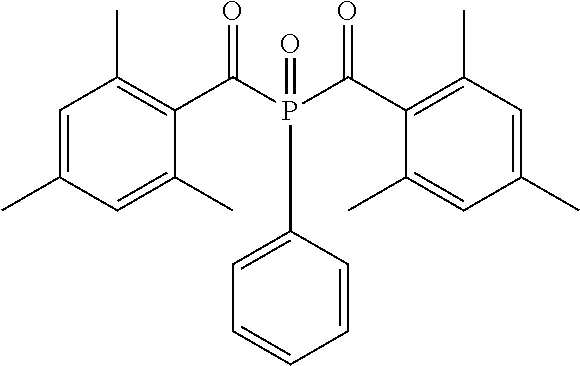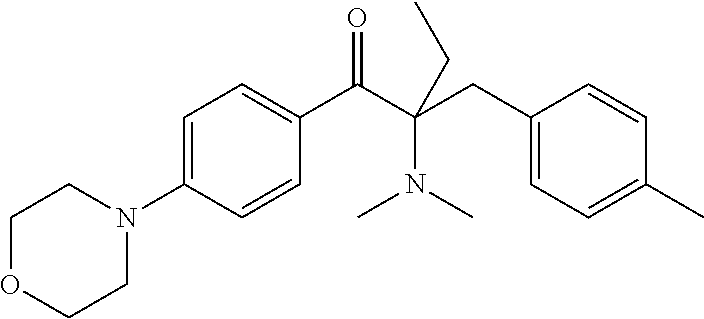Radiation curable fluids
- Summary
- Abstract
- Description
- Claims
- Application Information
AI Technical Summary
Benefits of technology
Problems solved by technology
Method used
Image
Examples
example 1
[0167]This Example illustrates the effect that polymeric dispersants have on the yellowing of radiation curable fluids including a vinylether acrylate monomer and a compound having a sulfonic acid group.
Preparation of Radiation Curable Fluids
[0168]A radiation curable fluid F-1 was prepared by mixing VEEA with 1 wt % of the stabilizer INHIB based on the total weight of the radiation curable fluid and adding 10 ppm of PTSA under stirring. The radiation curable fluids F-2 to F-7 were prepared by adding the polymeric dispersant in an amount according to Table 3.
TABLE 3CurablePolymeric DispersantFluidTypeAmountF-1——F-2DB162 50 ppmF-3DB162100 ppmF-4SS35000 50 ppmF-5SS35000100 ppmF-6E7701 50 ppmF-7E7701100 ppm
Evaluation and Results
[0169]The radiation curable fluids F-1 to F-7 were kept in a closed transparent container for 2 weeks at 25° C.
[0170]The APHA was measured just after preparation (Fresh), after 1 week and after 2 weeks. The results are shown in Table 4.
TABLE 4CurableAPHAFluidFres...
example 2
[0172]This Example illustrates the effect of the dispersant type on the viscosity and the dispersion stability of electron beam curable inkjet inks.
Preparation of Electron Beam Curable Inkjet Inks
[0173]The electron beam curable inkjet inks Ink-1 to Ink-4 were all prepared in the same manner.
[0174]First a concentrated cyan pigment dispersion was prepared by mixing for 20 minutes the 60 g of pigment Sun Fast Blue, 150 g of 40% solution of the polymeric dispersant (see Table 6) in VEEA and 1 g of the stabilizer INHIB in the monomer VEEA using a DISPERLUX™ disperser (from DISPERLUX S.A.R.L., Luxembourg). The mixture was then milled with Netzch MiniZeta wherein the internal volume was filled for 50% with 0.4 mm yttrium stabilized zirconia beads (“high wear resistant zirconia grinding media” from TOSOH Co.). The mixture was dispersed for 2 hours at a rotation speed of 3,000 rpm. During the complete milling procedure the content in the mill was cooled to a temperature of 42° C. After milli...
example 3
[0178]This Example illustrates the effect of the dispersant on the ink viscosity during storage of a UV curable inkjet ink.
Preparation of UV Curable Inkjet Inks
[0179]The UV curable inkjet inks Ink-5 and Ink-6 were prepared in the same manner.
[0180]Two concentrated cyan pigment dispersions were prepared by mixing PB15:4, a 30% solution of the dispersant in VEEA and the stabilizer INHIB for 30 minutes in VEEA in order to obtain a composition according to Table 8 using a DISPERLUX™ Dissolver (from DISPERLUX S.A.R.L., Luxembourg) and subsequently milling this mixture in a DYNOMILL ECM POLY mill (from BACHOFEN GmbH) having a bead filling of 42% with 0.4 mm yttrium stabilized zirconium oxide beads (“high wear resistant zirconia grinding media” from TOSOH Co.) for 120 minutes at a rotation speed of 10.4 m / s. After milling the dispersion was separated from the beads using a filter cloth.
TABLE 8Componentwt %PB15:415Dispersant15INHIB1VEEA69
[0181]These concentrated cyan pigment dispersions wer...
PUM
| Property | Measurement | Unit |
|---|---|---|
| Mass | aaaaa | aaaaa |
Abstract
Description
Claims
Application Information
 Login to View More
Login to View More - R&D
- Intellectual Property
- Life Sciences
- Materials
- Tech Scout
- Unparalleled Data Quality
- Higher Quality Content
- 60% Fewer Hallucinations
Browse by: Latest US Patents, China's latest patents, Technical Efficacy Thesaurus, Application Domain, Technology Topic, Popular Technical Reports.
© 2025 PatSnap. All rights reserved.Legal|Privacy policy|Modern Slavery Act Transparency Statement|Sitemap|About US| Contact US: help@patsnap.com



